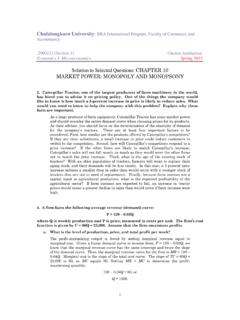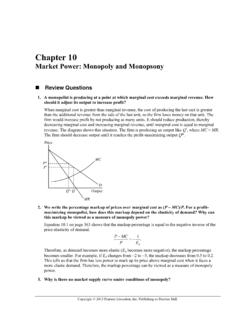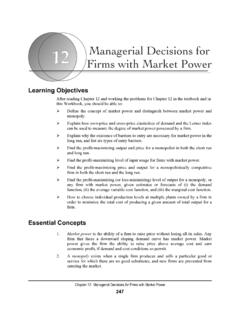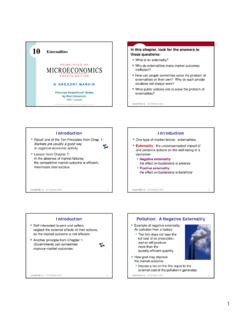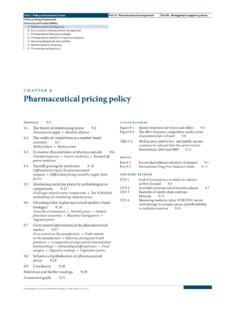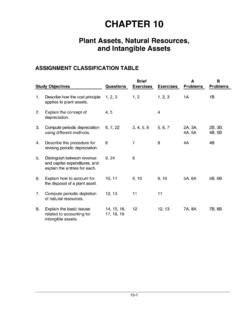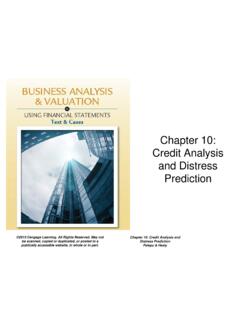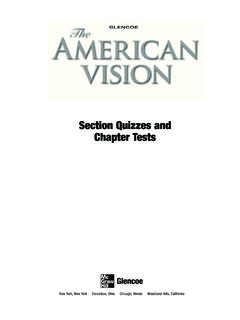Transcription of Chapter 10 Solar Energy - Home - Australian …
1 Australian Energy RESOURCE ASSESSMENT261 Chapter 10 Solar Summary KEy mESSagES Solar Energy is a vast and largely untapped resource. Australia has the highest average Solar radiation per square metre of any continent in the world. Solar Energy is used mainly in small direct-use applications such as water heating. It accounts for only per cent of total primary Energy consumption, in Australia as well as globally. Solar Energy use in Australia is projected to increase by per cent per year to 24 PJ in 2029 30. The outlook for electricity generation from Solar Energy depends critically on the commercialisation of large-scale Solar Energy technologies that will reduce investment costs and risks. Government policy settings will continue to be an important factor in the Solar Energy market outlook. Research, development and demonstration by both the public and private sectors will be crucial in accelerating the development and commercialisation of Solar Energy in Australia, especially large-scale Solar power stations.
2 World Solar Energy resources and market The world s overall Solar Energy resource potential is around gigajoules (GJ) ( megawatt-hours (MWh)) per square metre per year. The highest Solar resource potential is in the Red Sea area, including Egypt and Saudi Arabia. Solar Energy accounted for per cent of world total primary Energy consumption in 2007, although its use has increased significantly in recent years. Government policies and falling investment costs and risks are projected to be the main factors underpinning future growth in world Solar Energy use. The International Energy Agency (IEA) in its reference case projects the share of Solar Energy in total electricity generation will increase to per cent in 2030 per cent in OECD countries and per cent in non-OECD countries. Australia s Solar Energy resources The annual Solar radiation falling on Australia is approximately 58 million petajoules (PJ), approximately 10 000 times Australia s annual Energy consumption.
3 Solar Energy resources are greater in the northwest and centre of Australia, in areas that do not have access to the national electricity grid. Accessing Solar Energy resources in these areas is likely to require investment in transmission infrastructure (figure ). There are also significant Solar Energy resources in areas with access to the electricity grid. The Solar Energy resource (annual Solar radiation) in areas of flat topography within 25 km of existing transmission lines (excluding National Parks), is nearly 500 times greater than the annual Energy consumption of Key factors in utilising Australia s Solar resources Solar radiation is intermittent because of daily and seasonal variations. However, the correlation between Solar radiation and daytime peak electricity demand means that Solar Energy has the potential to provide electricity during peak demand times. Solar thermal technologies can also operate in hybrid systems with fossil fuel power plants, and, with appropriate storage, have the potential to provide base load electricity generation.
4 Solar thermal technologies can also potentially provide electricity to remote townships and mining centres where the cost of alternative electricity sources is high. Photovoltaic systems are well suited to off-grid electricity generation applications, and where costs of electricity generation from other sources are high (such as in remote communities). Australian Energy RESOURCE ASSESSMENT262 DARWINBRISBANEPERTHADELAIDESYDNEYMELBOUR NEHOBART150 140 130 120 10 20 30 40 AERA Average Solar Radiation0750kmExisting Solar power > 100 kW1000 - 2000 kWTransmission lines100 - 300 kW300 - 600 kW600 - 1000 kWMegajoules/m per day121314151617181920212224 Figure Annual average Solar radiation (in MJ/m2) and currently installed Solar power stations with a capacity of more than 10 kWSource: Bureau of Meteorology 2009; Geoscience Australia Relatively high capital costs and risks remain the primary limitation to more widespread use of Solar Energy .
5 Government climate change policies, and research, development and demonstration (RD&D) by both the public and private sectors will be critical in the future commercialisation of large scale Solar Energy systems for electricity generation. The Australian Government has established a Solar Flagships Program at a cost of $ billion as part of its Clean Energy Initiative to support the construction and demonstration of large scale (up to 1000 MW) Solar power stations in Australia s Solar Energy market In 2007 08, Australia s Solar Energy use represented per cent of Australia s total primary Energy consumption. Solar thermal water heating has been the predominant form of Solar Energy use to date, but electricity generation is increasing through the deployment of photovoltaic and concentrating Solar thermal technologies. In ABARE s latest long-term Energy projections, which include the Renewable Energy Target, a 5 per cent emissions reduction target, and other government policies, Solar Energy use in Australia is projected to increase from 7 PJ in 2007 08 to 24 PJ in 2029 30 (figure ).
6 Electricity generation from Solar Energy is projected to increase from TWh in 2007 08 to 4 TWh in 2029 30 (figure ). Background information and world Definitions Solar power is generated when Energy from the sun (sunlight) is converted into electricity or used to heat air, water, or other fluids. As illustrated in figure , there are two main types of Solar Energy technologies: Australian Energy RESOURCE ASSESSMENT263 Chapter 10: Solar Energy Solar thermal is the conversion of Solar radiation into thermal Energy (heat). Thermal Energy carried by air, water, or other fluid is commonly used directly, for space heating, or to generate electricity using steam and turbines. Solar thermal is commonly used for hot water systems. Solar thermal electricity, also known as concentrating Solar power , is typically designed for large scale power generation. Solar photovoltaic (PV) converts sunlight directly into electricity using photovoltaic cells.
7 PV systems can be installed on rooftops, integrated into building designs and vehicles, or scaled up to megawatt scale power plants. PV systems can also be used in conjunction with concentrating mirrors or lenses for large scale centralised Energy consumption (PJ)Share of total (%)1999- 2000- 2001- 2002-2003-2004- 2005- 2006- 2007- 2029-00 01 02 030405 06 07 08 30 YearAERA Projected primary consumption of Solar Energy in AustraliaSource: ABARE 2009a, 2010%AERA electricity generation (TWh)Share of total (%)YearFigure Projected electricity generation from Solar Energy in AustraliaSource: ABARE 2009a, 2010 ElectricitySolar RadiationPhotovoltaics (PV) Solar ThermalSolar cells, photovoltaic arraysHeat exchangeSolar Hot WaterConcentrating Solar ThermalParabolic trough, power tower,parabolic dish, fresnel reflectorAERA HeatSpace heating, food processingand cooking, distillation,desalination, industrialhot waterFigure Solar Energy flowsSource.
8 ABARE and Geoscience AustraliaAUSTRALIAN Energy RESOURCE ASSESSMENT264 Solar thermal and PV technology can also be combined into a single system that generates both heat and electricity. Further information on Solar thermal and PV technologies is provided in boxes and in section Solar Energy supply chainA representation of the Australian Solar industry is given in figure The potential for using Solar Energy at a given location depends largely on the Solar radiation, the proximity to electricity load centres, and the availability of suitable sites. Large scale Solar power plants require approximately 2 hectares of land per MW of power . Small scale technologies ( Solar water heaters, PV modules and small-scale Solar concentrators) can be installed on existing structures, such as rooftops. Once a Solar project is developed, the Energy is captured by heating a fluid or gas or by using photovoltaic cells.
9 This Energy can be used directly as hot water supply, converted to electricity, used as process heat, or stored by various means, such as thermal storage, batteries, pumped hydro or synthesised fuels. World Solar Energy marketThe world has large Solar Energy resources which have not been greatly utilised to date. Solar Energy currently accounts for a very small share of world primary Energy consumption, but its use is projected to increase strongly over the outlook period to highest Solar resource potential per unit land area is in the Red Sea area. Australia also has higher incident Solar Energy per unit land area than any other continent in the world. However, the distribution of Solar Energy use amongst countries reflects government policy settings that encourage its use, rather than resource Solar resourcesThe amount of Solar Energy incident on the world s land area far exceeds total world Energy demand.
10 Solar Energy thus has the potential to make a major contribution to the world s Energy needs. However, large scale Solar Energy production is currently limited by its high capital annual Solar resource varies considerably around the world. These variations depend on several factors, including proximity to the equator, cloud cover, and other atmospheric effects. Figure illustrates the variations in Solar Energy availability. The Earth s surface, on average, has the potential to capture around GJ ( MWh) of Solar Energy per square metre a year (WEC 2007). The highest resource potential is in the Red Sea area, including Egypt and Saudi Arabia (figure ). Australia and the United States also have a greater Solar resource potential than the world average. Much of this potential can be explained by proximity to the equator and average annual weather patterns. Development andProcessing, Transport,Resource ExplorationEnd Use MarketProductionStorageIndustrySolar photovoltaicElectricitySolar collectionThermalstorageCommercialPower plantsResource potentialSolar thermalElectricityWater heatingResidentialAERA Australia s Solar Energy supply chainSource: ABARE and Geoscience AustraliaAUSTRALIAN Energy RESOURCE ASSESSMENT265 Chapter 10: Solar ENERGYP rimary Energy consumptionSince Solar Energy cannot currently be stored for more than several hours, nor traded in its primary form, Solar Energy consumption is equal to Solar Energy production.

